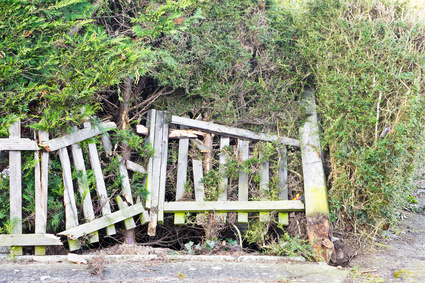Fence Damage: Landlord or Tenant Responsibility?
Published on February 9, 2018 by Sarah Mac

It’s that time of year when a fallen fence is not an uncommon site, but what if a fence has come down at one of your rental properties? Whose responsibility is it to put things right for fence damage?
Of course, with a fence down or damaged, privacy and security both become immediate issues. Here’s what you need to know as a landlord concerning garden fencing.
The Law on Landlord Responsibility and Fence Damage
The Landlord and Tenant Act 1985 and the Housing Act 2004 both define responsibility for repair and maintenance of the structure and interior of a property as being down to the landlord. This responsibility stretches to ensuring the exterior is maintained in good repair and as such includes the exterior walls, roof, foundations, windows, doors – and fencing.
Therefore, if damage occurs to any part of the exterior structure that could put a tenant’s safety or well-being at risk, then the landlord is liable for its repair. If repair for non-essential or cosmetic reasons is requested however, then as a landlord, you are not required by law to agree or foot the bill. Neither are you required to pay for any damage that was caused by tenant negligence or anything that would constitute a breach of the tenancy agreement.
Let’s take a look at the way in which the fence became damaged in closer detail.
Natural Forces versus Tenant Damage
Natural forces leading to fence damage will generally fall to the landlord to cover the costs of repair or replacement. So, if a fence is damaged following a storm, high winds, a flood or something else along those lines, then you will be responsible for mending it. Precisely why mid-term inspections are so important so you can check the condition of external structures on a regular basis to ensure they are strong enough to stand up to the elements. A simple repair of a weakened fence, and regular maintenance through weatherproof staining, could mean you’ll avoid the expense of a full replacement.
If a fence has been damaged by a tree falling on it, or by fire emanating from a neighbouring property for example, then you will be able to look to the owner of that property to cover the costs, which should be covered by their own insurance.
Fences that are damaged through tenant negligence are down to the tenant to cover the cost, provided you can prove the damage was their fault.
Considerations When Making a Claim Against a Tenant Deposit
If you wish to make a claim on the tenant’s deposit, then you will need to supply detailed written and photographic evidence of the condition of the fence at the start of the tenancy and / or during any mid-term inspection. Common issues that are often down to negligence include fences damaged by bonfires or fireworks; fences that are weakened by having heavy plants or other decorative items hung on them by tenans and fences damaged by pets or children climbing on them.
If you stipulate in your tenancy agreement that your tenants are responsible for maintaining the fence in good order, i.e. regularly staining or painting it, then if they fail to comply and the fence deteriorates as a result, you will usually be able to pass on the costs of any necessary repairs. However it is fairly uncommon for landlords to pass on responsibility for fence maintenance to their tenants.
Always remember that if you do need to make a claim against your tenants for any sort of damage, it will need to be fair and that betterment is not allowable by law. So if a tenant has damaged a small section of fence, you won’t be able to claim for a complete new fence.
Education is Essential, as is a Detailed Inventory and Check-in Report
It is good practice to educate your tenants in the importance of reporting any issues they notice in a timely fashion. Make sure they know to advise you if they spot any fence panels missing or a fence that is moving or creaking in the wind, or a neighbouring tree that looks like it may give cause for concern. Also be sure to keep fence-side vegetation down as best you can to make it easier to detect potential issues.
Remember, a detailed, accurate and comprehensive inventory and check-in report with plenty of photographic evidence will always protect you should you ever need to make a claim against your tenant’s deposit for anything, including fence damage.

